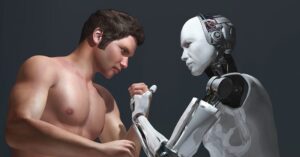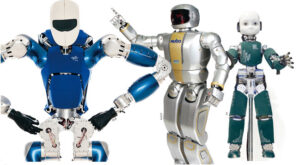Introduction
Humanoid robots represent a fascinating intersection of robotics and artificial intelligence, aiming to mimic human-like appearance and behavior. The development of humanoid robots has seen both significant challenges and breakthroughs. Let’s explore some key aspects:
Challenges:
Mechanical Design: Achieving human-like movement and dexterity poses a considerable challenge in designing joints, limbs, and overall body structure.
Ensuring a balance between stability and flexibility is crucial for humanoid robots to navigate diverse environments.

Power Consumption: Creating energy-efficient humanoid robots remains a challenge, as replicating human-like movements often requires substantial power.
Battery technology and power management systems need to be improved for extended operation without frequent recharging.
Cognitive Capabilities: Developing advanced artificial intelligence for humanoid robots to perceive and interpret their surroundings in real-time is challenging.
Implementing natural language processing and understanding human emotions adds complexity to their cognitive abilities.
Human Robot Interaction: Ensuring safe and seamless interaction between humans and humanoid robots is vital. Avoiding accidents and understanding human gestures and intentions are complex tasks.
Ethical considerations, privacy concerns, and social acceptance are important factors to address.
Breakthroughs:
Advancements in Artificial intelligence: Breakthroughs in AI, especially in machine learning and deep learning, have enhanced humanoid robots’ ability to learn and adapt to different situations.
Sensor Technologies: Improved sensor technologies, including cameras, LidAar and tactile sensors, enable humanoid robots to perceive and interact with their environment more effectively.

Materials and Actuators: Innovations in materials and actuators contribute to the development of more human-like movements and gestures, allowing for greater agility and flexibility.
Could Computing Integration: Integration with cloud computing enables humanoid robots to access vast amounts of data and processing power, enhancing their overall capabilities.
Collaborative Research and Open Source Platforms: Collaborative efforts among researchers and the availability of open-source platforms facilitate knowledge sharing and accelerate the development of humanoid robots.
Humanoid Robot Application: Humanoid robots have found applications in various fields, including healthcare, customer service, and education, showcasing their potential benefits and driving further research and development.
As technology continues to advance, the challenges posed by humanoid robots will likely be met with innovative solutions, leading to even more breakthroughs in this exciting field.
What are the challenges and opportunities in human robot interaction?
Human-robot interaction (HRI) presents both challenges and opportunities as technology continues to advance. Here are some key aspects to consider:
Human robot interaction faces challenges and opportunities. Challenges include maintaining situational awareness and trust in environments.

Natural Communication:
Challenges: Developing robots that can understand and respond to human communication in a natural and intuitive way is a significant challenge. Understanding context, emotions, and non-verbal cues can be complex.
Opportunity: Progress in natural language processing, computer vision, and emotion recognition can enhance the robot’s ability to engage in more natural and fluid conversations.
Safety Concerns:
Many people may feel uncomfortable or uneasy interacting with robots, particularly if they perceive them as a threat to their jobs or as a potential privacy concern.
Educating the public about the benefits of robots, addressing misconceptions, and designing robots to be more approachable and user-friendly can contribute to increased social acceptance.
Opportunities:
Enhanced Productivity:
Robots can assist and collaborate with humans, increasing overall productivity. This is particularly valuable in industries like manufacturing, healthcare, and logistics.
Improved Quality of life: Robots can be designed to assist individuals with disabilities or provide support for elderly populations, enhancing their quality of life by performing tasks that might be challenging for them.
Efficient and Repetitive Tasks: Robots excel at performing repetitive and monotonous tasks with precision and consistency, freeing up humans to focus on more complex and creative aspects of their work
Customization and Personalization: Robots can be tailored to meet specific needs, whether in terms of personal assistance, entertainment, or healthcare, providing customized solutions for individuals.
Education and Skill Development: HRI offers opportunities for education and skill development, allowing humans to interact with robots in learning environments, fostering technological literacy, and preparing individuals for future job markets.
In navigating the challenges and leveraging the opportunities in human-robot interaction, it is essential for developers, policymakers, and society at large to work together to ensure responsible and ethical integration of robotics into various aspects of daily life.
The Problems with Robot Humanoid?
At Cobot, we’re developing a collaborative robot to bring those benefits outside of the four walls of an Amazon fulfillment center or sort center or air hub and into
Spot mini, a four legged is a beautiful feat of engineering.

Complexity and Cost: Designing and manufacturing humanoid robots with advanced capabilities is a complex and expensive process. The intricate mechanisms required for human-like movement and functionality often result in high production costs.
Balance and Stability: Achieving stable and balanced movement in humanoid robots, especially in dynamic and unstructured environments, is a significant challenge. Maintaining equilibrium, avoiding falls, and adapting to various terrains are ongoing research areas.
Sensory and Perception challenges: Providing humanoid robots with advanced sensory capabilities to perceive and understand their surroundings is a complex task. While there have been advancements in sensors, mimicking the complexity of human perception, including touch, vision, and spatial awareness, is still a work in progress.
Maintenance and Repairs: Humanoid robots are susceptible to wear and tear, and their maintenance and repair can be challenging. Ensuring long-term functionality and reliability requires addressing issues related to durability and ease of repair.
Regulatory and Legal Challenges: As humanoid robots become more prevalent, establishing appropriate regulations and legal frameworks for their use and potential liability becomes essential.
Despite these challenges, ongoing research and advancements continue to improve humanoid robot capabilities, making them increasingly viable for specific applications and roles.
Artificial intelligence and Decision Making: Developing robust artificial intelligence (AI) systems for humanoid robots is crucial for tasks such as navigation, object recognition, and decision-making. Ensuring these systems are reliable, ethical, and safe presents ongoing challenges.
Conclusion:
In conclusion, the realm of humanoid robots presents a dynamic landscape of challenges and breakthroughs. While technological strides have fueled advancements in artificial intelligence, mobility, and human-robot interaction, hurdles persist. Issues such as ethical considerations, societal acceptance, and the need for seamless integration into daily life remain formidable. Breakthroughs in sensor technology, machine learning, and collaborative research efforts, however, offer promising solutions. As humanoid robots inch closer to practical applications in healthcare, industry, and beyond, the delicate balance between innovation and ethical implications necessitates careful consideration. The future hinges on addressing these challenges to unlock the full potential of humanoid robotics in enhancing our lives.

